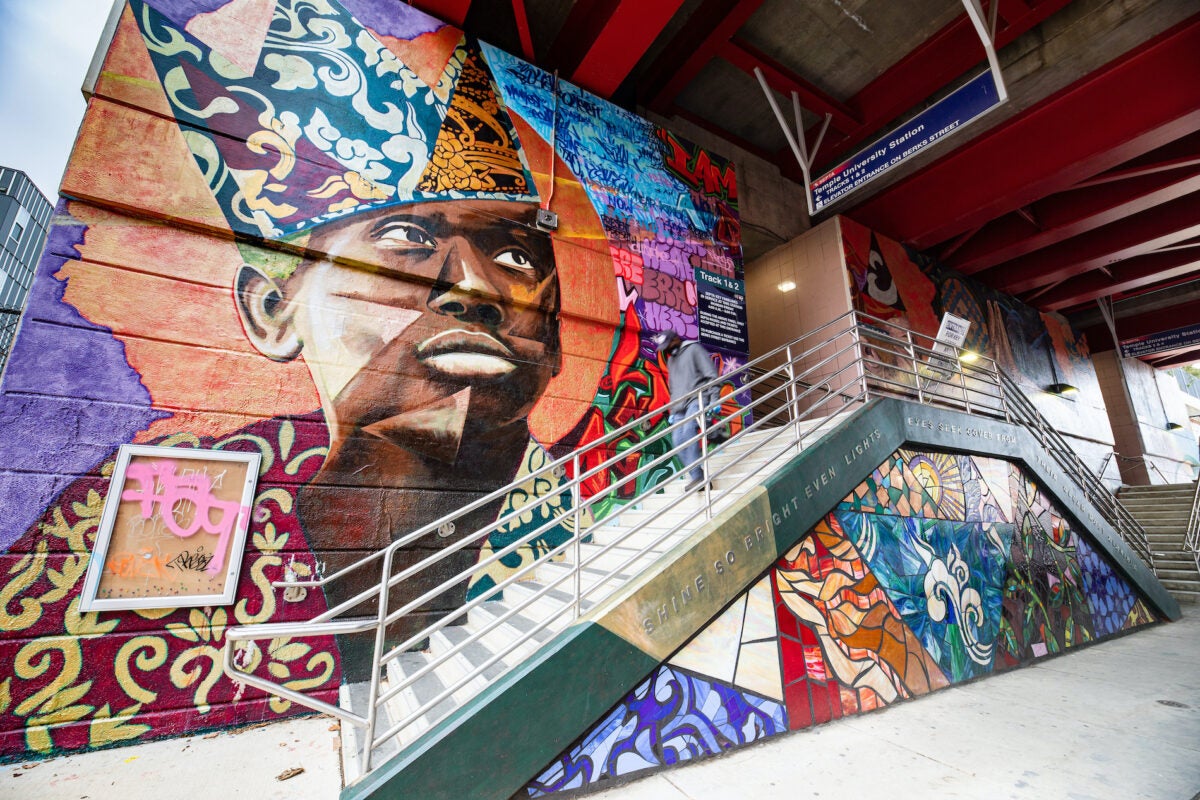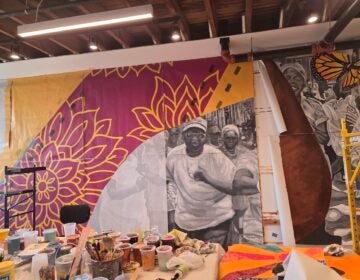Philly has 3,600 murals and few ways to protect them
If the owner of a wall wants to get rid of the mural on it, there isn’t much the artist or community can do. Jane Golden wants to change that.

Vote © 2020 Faust, 245 South Street. (Photo by Steve Weinik)
At any given time, close to 1,000 Philadelphians are on a waiting list for murals.
“We live in a city that thinks about art,” Jane Golden, Mural Arts Philadelphia executive director, said. “Philadelphia is a mural city.”
Every year, Golden and her team complete 75 of the community-driven artworks, adding to an urban canvas rich with 3,600 (and counting) murals.
But once these paintings go live, their future is far from assured. Every wall has an owner and that owner who can do whatever they want with their property — with or without Mural Arts’ consent.
Now Golden wants to change that, especially after last month’s white-washing of the mural featuring Latina activist Gloria Casarez.
Limited protections
The sudden disappearance of the iconic wallside painting by Michelle Angela Ortiz shocked Golden. Up until that point, Mural Arts planned to work with the building owner, Midwood, to create an even bigger mural at the site following the demolition of the building that had featured the Casarez portrait since 2015.
Mural Arts stopped plans to work with Midwood after the incident.
Golden said this incident was particularly jarring but it’s not unusual for murals to just one day disappear. She estimates a loss of three to six murals annually.
“We know we’re in a city with this extraordinary collection of public art and we need to protect it,” she said.
That’s easier said than done. Right now, the only thing Mural Arts owns is the copyright with the artist. Golden has tried to create rules mandating how many years the mural must stay on a wall but the efforts haven’t advanced.
“It’s really hard to get people to work with us on that because they always want that option to sell or turn over the property if they want, without feeling that they’re going to end up in litigation,” Golden said.
In years past, murals survived because their owners weren’t building anything new. With the pace of development accelerating, she’s now in constant fear of murals vanishing.
Her remedy?
She thinks that if construction vanquishes an artwork, like in the case of the Gloria Casarez mural, the developer should replace it with a new piece.
“I think people doing business in the city should understand they’re making a living from our city and this is a very conscious and intentional way to give back in a way that will make a difference,” Golden said.
But before the city can ask developers to replace the public artworks, they need to know where they are. In November, City Councilmember Katherine Gilmore Richardson introduced legislation supported by Golden that would create a database cataloguing all of the murals in the city.
“Preserving our public art shows our commitment to local neighborhoods and to the artists and arts organizations who have worked to make our city beautiful,” Gilmore Richardson said.
The bill would require Mural Arts to review all construction plans that would affect its artistic creations. Anytime a building permit request is filed for an alteration to a muralized structure, the city’s Department of Licenses and Inspections would have to forward the application to Golden’s agency for review before issuing the permit.
Mural Arts’ review would be limited to a 45-day comment period by the end of which the agency would send recommendations to L&I. Gilmore Richardson said she expects to hold hearings about the bill in the spring.

How to get a mural made
It’s hard to say how long a project can take because every mural is different — some have been completed as quickly as three weeks and others have taken as long as a year and a half.
Applying for a project is pretty simple. It starts with an online application that asks questions about the project’s topic, organizational and funding support, and why the idea is relevant to the city or a neighborhood. It helps if the application also nominates a wall where the project can be done but it’s not required. Artists can apply if they want to be the lead on the work.
In the case that an applicant already has a wall in mind, which is ideal, Mural Arts does a small community audit to see if this is something that is wanted. If the applicant doesn’t have a wall, the organization will search for a blank canvas.
Walls that have smooth stucco and foot traffic are preferred. Parking lot walls are good because it’s less likely something will block the mural. Stains are a red flag because they are a sign of leaks that could ruin the artwork.
The strongest submissions usually center around contemporary issues. An example would be this summer’s Black Lives Matter mural on the facade of the Municipal Services Building. It also helps if a project is pitched for a section of the city where there aren’t many murals.

The organization starts with talking to the owner of the wall and its neighbors, usually within a three-block radius.
After that, they will host a larger community meeting to introduce the idea of a project coming. In particular, they look for block captains, community leaders, town watch groups, local libraries, and district leaders.
“We know it’s imperfect but we want to make sure that we’re making the rounds,” Golden said.
If the community is receptive and an artist wasn’t involved in the application, the next step is to ask if there are any artists within the neighborhood who would be interested in applying.
If the answer is no, there are two options: Mural Arts presents 12 to 15 potential portrait artists who could do the project or the organization will put out a request for proposal on its site. Golden says the RFP option is more time-consuming but it opens the opportunity up to their entire city.
Once the artist is picked, they work with the wall owners and other neighbors through an artistic advisory committee.
Concept drawings are shared with the committee and other engaged community groups. Aesthetic issues are also vetted with Mural Arts staff through an agency process.
Once the designs get the necessary approvals, the lead artist and their team get to work. That usually means using large squares of polyester fabric called “parachute cloth” in studios. During this phase, community residents can come and paint with the artists.
“People feel a great sense of ownership because they’ve been involved in the conceptualization,” Golden said. “They’ve been involved, maybe even making it, putting the brush to the parachute cloth.”
After that’s done, the cloth adheres to the wall with three coats of acrylic gel.
When the mural is complete, there’s always a neighborhood celebration. Mural Arts officiates over about 150 dedications a year. Every one of them looks a little different — much like the murals themselves — and that’s a good thing, said Gilmore Richardson.
“Our city’s murals are representative of the fabric and character of the diverse communities and values in Philadelphia,” she said.

Subscribe to PlanPhilly
WHYY is your source for fact-based, in-depth journalism and information. As a nonprofit organization, we rely on financial support from readers like you. Please give today.







